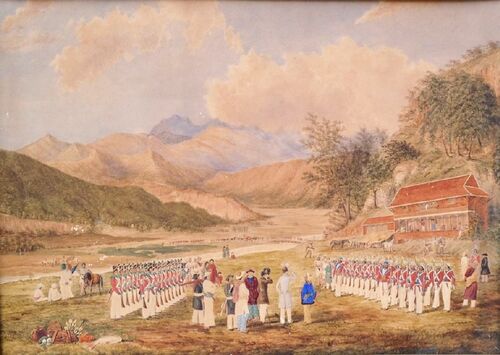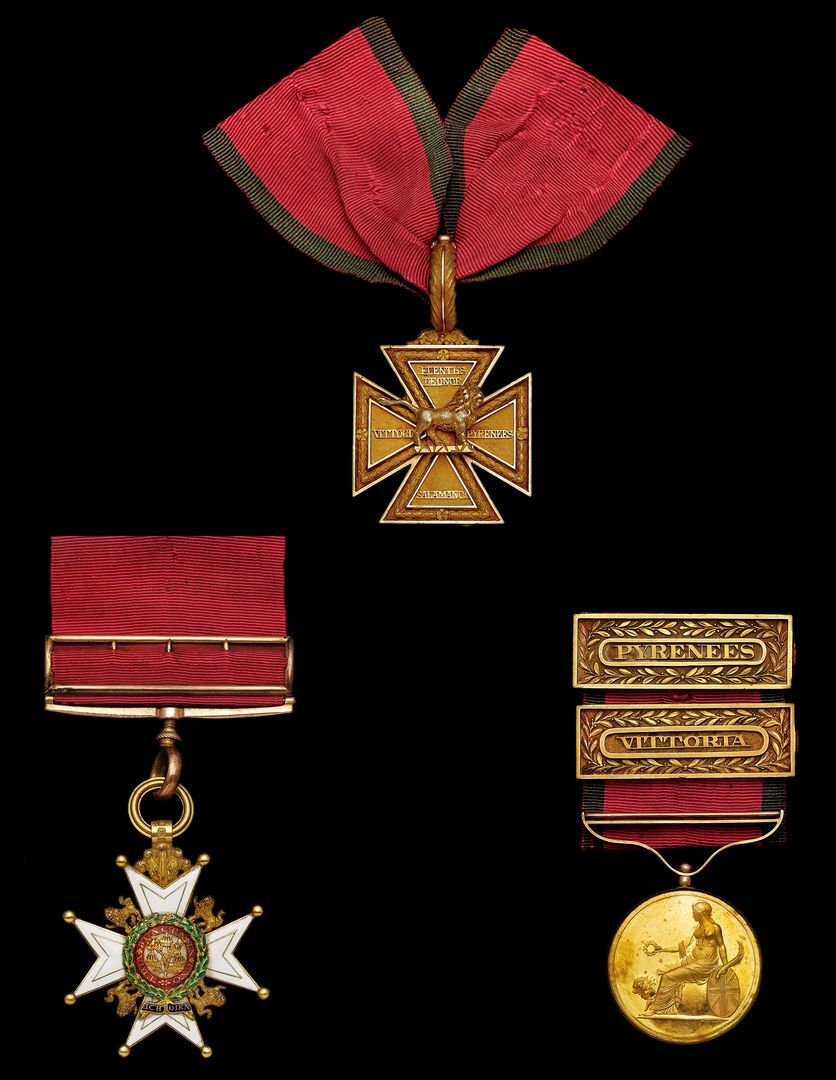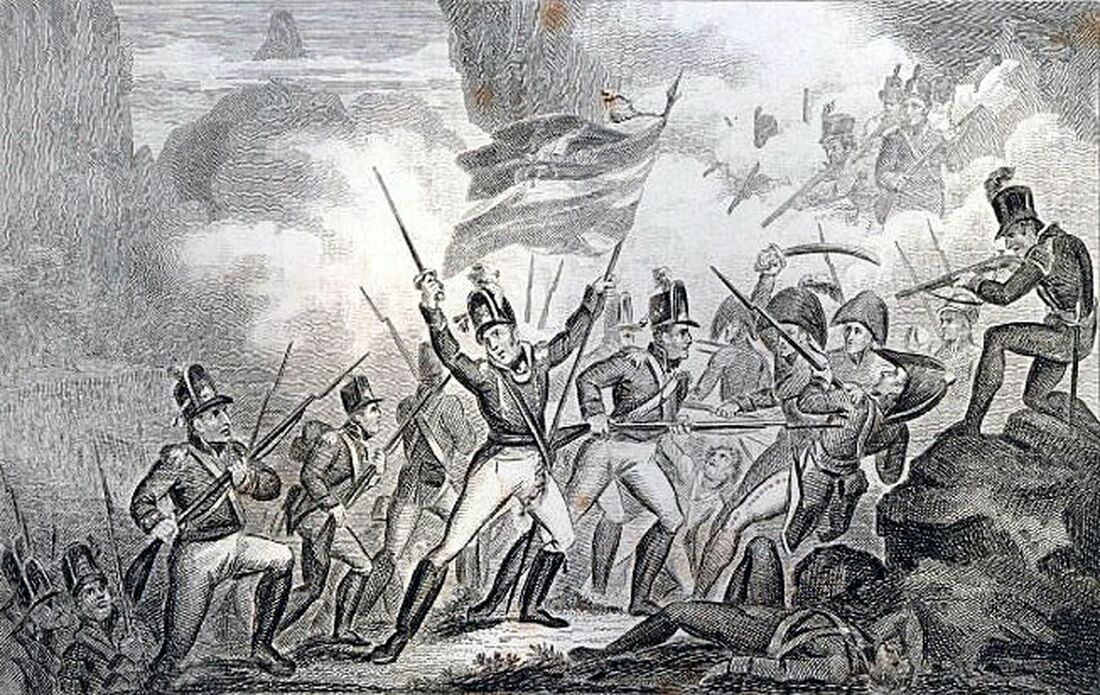Auction: 24001 - Orders, Decorations and Medals
Lot: 51
(x) 'I particularly request your Lordship's attention to the conduct of...Lieutenant-Colonel Kelly, of the 24th Regiment...'
Lieutenant-General Viscount Wellington to the Earl of Liverpool, 8th May 1811
The exceptional and regimentally unique C.B., Army Gold Cross and Small Army Gold Medal group of three awarded to Colonel W. Kelly, 24th (The 2nd Warwickshire) Regiment of Foot, who led his Battalion with great skill and gallantry during the Peninsular War and later commanded a Column during the Anglo-Nepalese War in 1816
(i)
The Most Honourable Order of the Bath (C.B.), Military Division, Companion's breast Badge, gold and enamel, 22 carat gold and enamel, hallmarks for London, date letter ‘U’ for 1815, maker’s mark ‘IE’ for John Edwards, complete with wide straight-bar suspension and gold three-pronged riband buckle, minor loss to reverse centre
(ii)
Army Gold Cross 1806-14, for Fuentes de Onor, Salamanca, Vittoria, Pyrenees (Colonel Wm. Kelly 24th. Regt. Foot)
(iii)
Field Officer’s Small Gold Medal 1808-14, obverse signed Marchant, for Fuentes de Onor, 2 clasps, Vittoria, Pyrenees (Lieut. Colonel William Kelly.), post a little bent on this last, good very fine overall (3)
C.B. London Gazette 16 September 1815.
William Kelly, one of seven children of Thomas and Jane Kelly of Dawson's Grove, County Armagh, was born circa 1770 and commissioned Ensign (by purchase) into the 28th (North Gloucestershire) Regiment of Foot in December 1785. At that time stationed in south-west Scotland, a year later the regiment removed to western Ireland (with their Headquarters in Galway) and Kelly is noted as Ensign in Captain Charles Smyth's company; in April 1787 he is specifically noted as commanding a recruiting party to assist in bringing the 28th up to full strength. 1787 was also a significant year for the teenage Kelly, as in August he transferred (as Ensign) to Captain William Campbell's company of the 24th (The 2nd Warwickshire) Regiment of Foot - probably in a very deliberate move, as his sister Alicia married Campbell in May 1788. Kelly was to remain with the 24th Foot for the rest of his life.
In April 1789, the 24th crossed the Atlantic to be stationed at Quebec, Montreal and, from the summer of 1792, at Detroit - at first sight an unusual location, but at this time an area disputed in its ownership between Britain and the recently established United States of America. Kelly purchased promotion to Lieutenant in June 1792 and remained at Detroit until its cession to the United States in 1795. In January 1793, he had been appointed Adjutant and remained so until December 1797 - a posting which indicated good professional knowledge and sound understanding of the running of the battalion, and which would have seen him working closely with the Commanding Officer and Regimental Sergeant-Major.
Promoted Captain-Lieutenant and then Captain late in 1795, the 24th remained in Canada (variously at Quebec, Montreal and Halifax) until returning home in late-1800. On ceasing to be Adjutant, Kelly was almost immediately appointed Acting-Paymaster until promoted Major (by purchase) in April 1799. Thus, before he was 30, he had commanded his own company, held the two most important posts on the regimental staff and achieved field rank. Furthermore, on 16 April 1797, at Montreal, he was elected a member of the Loyal Society of the Blew and Orange (a regimental club founded by the 4th (or The King's Own) Regiment of Foot), whose name encapsulated its Loyalism and whose activities resembled a form of military freemasonry. However, whilst Kelly's star was clearly in the ascendant, he had still seen no active campaigning against the enemy - though this was shortly to change in dramatic fashion.
In 1801 the 24th Foot were detailed for service as part of Lieutenant-General Sir Ralph Abercromby's expeditionary force with the objective of finally expelling the French from Egypt - though they arrived too late for the landing at Abukir (8 March 1801), Kelly and his men were likely part of the force involved in the siege and capture of Alexandria in September that year. Returning home in 1802, they remained in Britain until late 1805; the 24th received authorisation to raise a second battalion in 1803 and, perhaps related to the expansion of the regiment, Kelly received a brevet lieutenant-colonelcy in January 1805. Whilst the 2nd/24th (as the junior battalion) remained in Britain, the 1st/24th were ordered on 'Foreign Service' for the expedition to capture the Dutch colony at the Cape of Good Hope: landing there in January 1806 in the face of only slight and ineffective resistance, the British force swiftly achieved its' objectives and the Cape (of vital strategic importance for trade and commerce with India and the Far East) was secured. The battalion remained at the Cape until 1810 on garrison duty, with Kelly in command between early 1807 and late 1808.
In mid-1810 they were ordered to India and, at the same time, Kelly was ordered home on promotion to Lieutenant-Colonel and to assume command of the 2nd Battalion, whose Commanding Officer had been severely wounded at the Battle of Talavera. This posting likely saved his career, as the vast majority of his old command were captured at sea - during a battle known as the 'Action of 3 July 1810' - when a French frigate squadron captured the East India Company ships transporting them to India. They were, however, released a year later and Kelly was to see them again.
Arriving in the Peninsula in 1811, he joined the army and took command of the 2nd Battalion on 5 May - the final throes of the Battle of Fuentes de Onoro, a hard-fought action over several days and in which the 24th (brigaded with the Highlanders of the 71st and 79th regiments) were in the thick of the fighting for the village which gave its name to the battle. Though the Regimental History of the 24th Foot states that Kelly did not take command until the day after the battle, this appears to be incorrect as Kelly earned a 'Mention' in Wellington's despatch following the engagement: 'I particularly request your Lordship's attention to the conduct of...Lieutenant-Colonel Kelly, of the 24th Regiment...' (The London Gazette Extraordinary, 26 May 1811, refers), and of course the first of his awards with the Small Army Gold Medal.
The next major engagement for Kelly and his men was at Salamanca (22 July 1812), and though on this occasion they were not heavily engaged - being in support on the left flank of Wellington's army - this notched up another mark of medallic qualification for the Commanding Officer of the 24th. However, the subsequent campaign which resulted in the awful winter retreat from Burgos back to Portugal (likened by Peninsular veterans to a second retreat to Corunna in 1809) so shattered the 2nd Battalion that they were ordered to form a composite unit - titled the 3rd Provisional Battalion - with the similarly-decimated 2nd/58th Regiment of Foot. Though perhaps not ideal for Kelly (Provisional battalions being viewed as having less 'esprit de corps' than a standard battalion), he remained in command of his new unit and was indeed promoted brevet Colonel in January 1813. It was in this capacity that he led his men at the Battle of Vittoria (21 June), again on the left flank of Wellington's army, although their part in the action was delayed due to the Seventh Division losing its' way on the advance to contact with the French.
After this shattering victory, the Allied army steadily advanced in the direction of the frontier with France and Kelly was next in action during the Battle of the Pyrenees, a series of small but fierce engagements fought over 25 July - 2 August 1813. Not least of these was the storming of the heights of Eschalar, when Major-General Barnes's Brigade (mostly consisting of men commanded by Kelly) assaulted and carried a position held by two French divisions - an act which directly led to a 'Mention' in Wellington's Despatch:
'Major-General Barnes' brigade was formed for the attack, and advanced, before the fourth and light divisions could co-operate with them, with a regularity and gallantry which I have seldom seen equalled, and actually drove two divisions of the enemy, notwithstanding the resistance opposed to them, from those formidable heights. It is impossible that I can extol too highly the conduct of Major-General Barnes and these brave troops, which was the admiration of all who were witnesses to it.' (Historical Records of the 24th Regiment, from its formation, in 1689, 1892, p.129 refers). Testament to Kelly's active participation can readily be seen by the fact that he is noted as being wounded during this action - and though the nature of the wound was not disclosed, it appears serious enough to have affected him for the rest of his life.
The conclusion of the Peninsular War led to the disbandment of the severely under-strength 2nd Battalion and, having returned to England in late 1814, Kelly had little time for leisure before being ordered to take command of a large draft of reinforcements out to India to join the 1st Battalion: they set sail in February 1815 and arrived nine months later. In the intervening period, Kelly was amongst the first batch of officers to be appointed to the newly-expanded Order of the Bath by being made Companion in the Gazette of September 1815 (effective from 4 June). Once in-theatre, Kelly rejoined the 1st/24th - and one hopes he was reunited with several friends and comrades from his days in South Africa and before.
He was subsequently appointed to command a Brigade comprising the 24th Foot, the 1st/18th Bengal Native Infantry and elements of the 2nd, and the Champara Light Infantry; under overall command of Major-General David Ochterlony, they took the field in early 1816 and by 27 February had reached a significant Gurkha fort at Hariharpore. The Regimental History takes up the story:
'Early in the morning of 1st March, a force under Lieutenant-Colonel O'Halloran, H.E.I.C.S., was sent forward to occupy a height in front of the fort. The enemy kept up a smart fire of guns and small-arms until some field pieces were brought to bear upon them, with such effect that at 3 p.m. their fire was silenced. The 24th had four men killed and Brevet-Major Chas. Hughes, Captain Smth, Lieutenant O'Leary and twenty-seven men wounded on the occasion. Next day the regiment marched into the fort which had been abandoned during the night.
On 6th March, 1816, peace was concluded with the Rajah of Nepaul, and the regiment returned to Amowa, whence it marched, on 5th July, to Dinapur, arriving there on 18th July.' (ibid, p. 96).
The 'peace' referenced here was the Treaty of Sugauli, which saw a large amount of former Nepalese territory ceded to the East India Company. Kelly's services during this campaign earned him a further Mention in Despatches from the Marquess of Hastings, Governor-General of India: 'The conduct of Colonel Kelly, in the command of a detached column directed against Hurryhurpore, is justly entitled to our high approbation'... (London Gazette, 10 August 1816, refers).
It is likely that Kelly resigned his command no later than mid-1816 in order to return home: perhaps his old Peninsular wound was troubling him, and the Anglo-Nepalese War had also seen a significant number of troops come down with dysentery and other ailments in the inhospitable climate. These factors almost certainly contributed to Kelly's early death, at Littlecote House, Chilton Foliat, Wiltshire, on 21 August 1818, and is buried at St. Mary's Church in that village. The military members of the Kelly family are remembered today with a large and impressive memorial in Armagh Cathedral, and William himself has a further memorial tablet in St. Mary's Church to which must surely go the last word:
'Colonel Kelly's services were extended to the four quarters of the globe: he was severely wounded at the Battle of the Pyrenees and exhausted afterwards by his successful exertions in the Nepaul War in India. He returned only to breathe his last with his friends, admired in his profession as a soldier, and esteemed by all as a man.'
Subject to 5% tax on Hammer Price in addition to 20% VAT on Buyer’s Premium.
Sold for
£86,000
Starting price
£45000





















